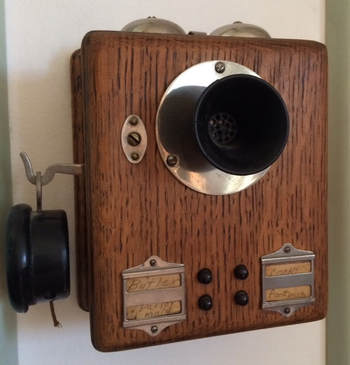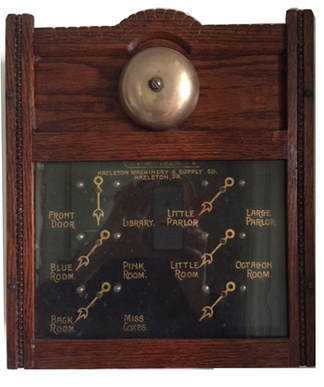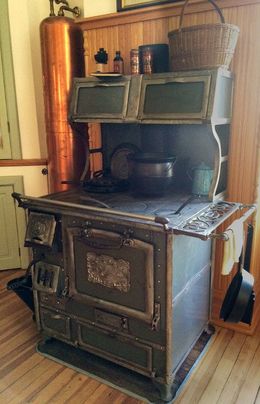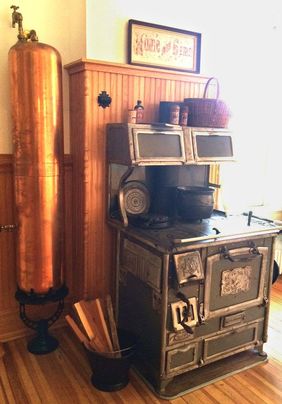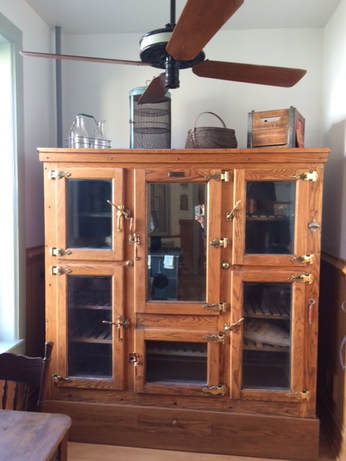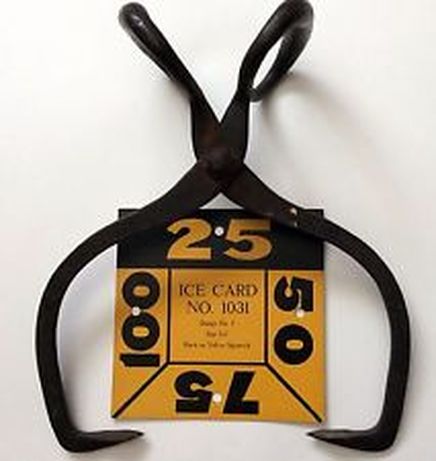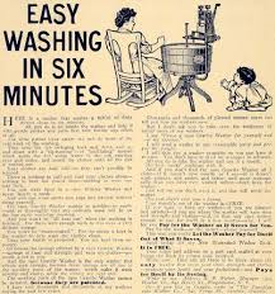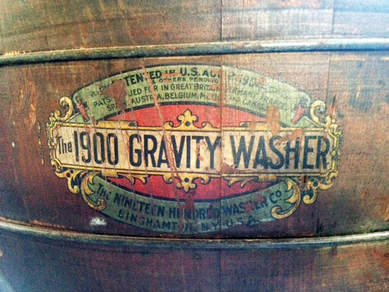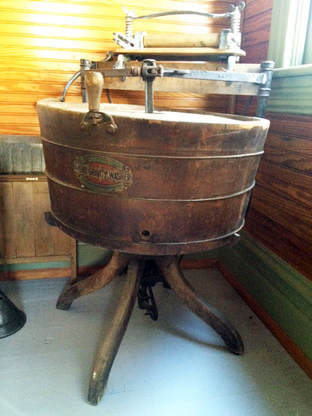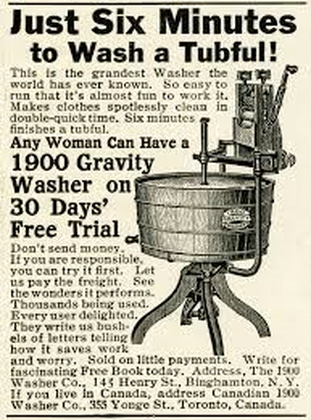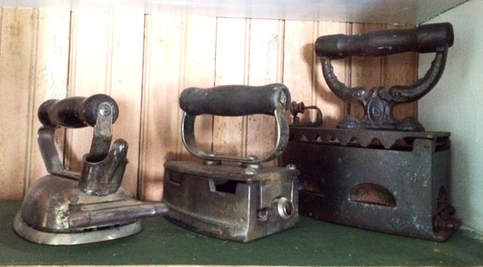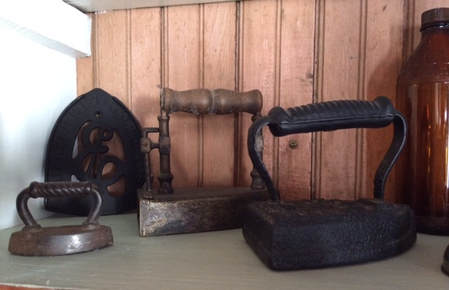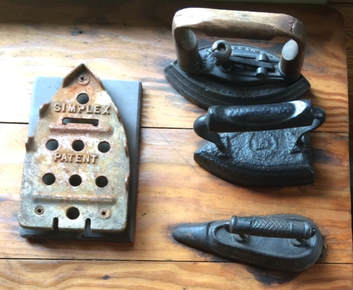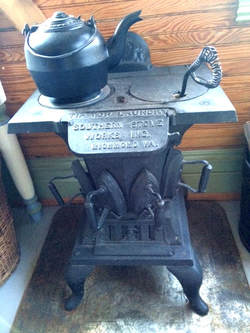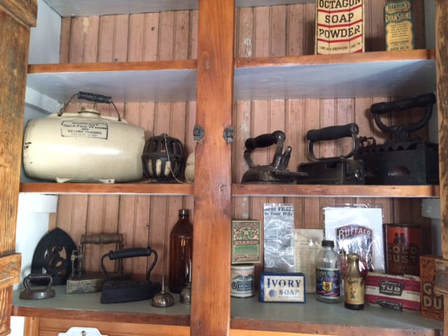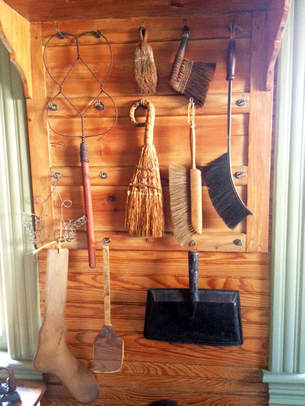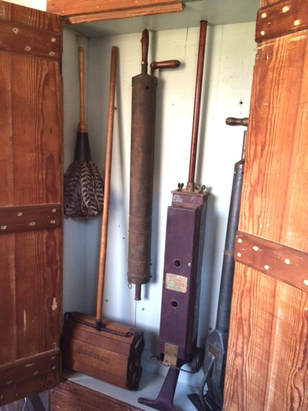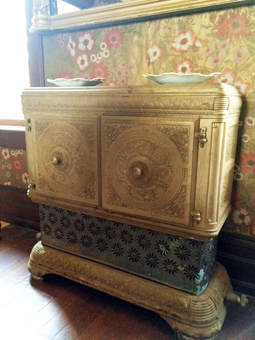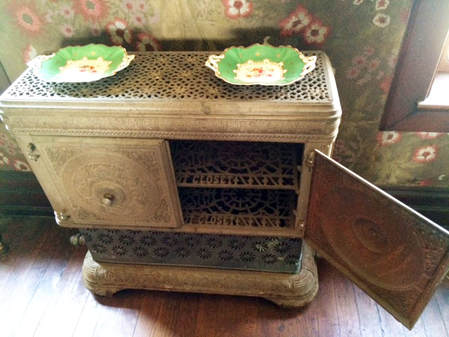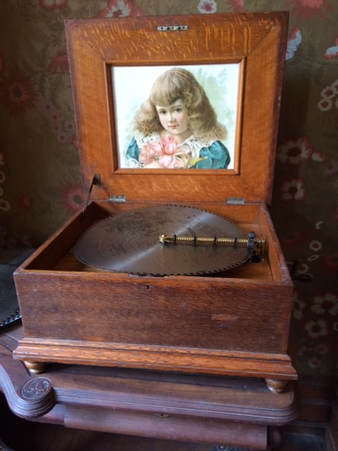Perhaps nowhere in the house saw as much technological advancement as the servant quarters. At the turn of the 20th century, a variety of inventions came on the market to lessen the drudgery of housework.
The Annunciator
Large residences benefitted from speaking tubes which, like an intercom system, allowed communication without traversing stairs. Call stations were on each floor; the master box was located in the servant hall near the kitchen.
Fire Equipment
Fire was a constant peril in homes using fireplaces and coal stoves. An errant spark on a carpet or drapery could easily travel within balloon framed walls and engulf the entire structure before the town’s fire department arrived. Consequently, buckets of sand were kept near open flames. Personal handheld extinguishers were another means of dealing with fire. Early models made of cardboard or metal tubes filled with dry chemicals were thrown whole into a blaze rather than sprayed.
Home Comfort Stove, c. 1900
The work horse of small ranges, this sturdy wood-fired stove did it all from cooking on the four burners, to baking in the oven, keeping food warm in the upper bins and heating water in an optional side tank. This model features a gray enamel finish, built-in deep well kettle, chrome towel bar, cast iron extension shelf and the requisite pot lifters. In lieu of a water jacket, a copper hot water tank on a cast iron stand is connected to 5400's stove.
McCray Cooler, c. 1908
Kendallville, Indiana
Until modern refrigerators, ice boxes were the answer to preserving meat, dairy and other perishables. Households normally received a weekly delivery of ice. Size of the block was determined by a card left in the window for the iceman stating the desired weight. McCray made ice boxes for home and commercial use. This large oak unit with eight compartments features clear glass for easy viewing of the contents. The ice was stored behind the mirrored panel. A bottom drawer allowed for drainage.
The Model 1900 Gravity Washer
This state of the art washing machine boasted that a woman could do a load in six minutes by simply sitting and turning the crank handle. To encourage sales, mail order catalogs allowed potential buyers to order one at no cost and test it in their homes for a month. The upscale combination washer-dryer model included a hand-operated wringer.
Sad Irons
Prior to gas and electric irons, laundry was pressed free of wrinkles with heavy, flat smoothing irons heated in a fire or on a stove. The solid metal irons had to be grasped with a rag to prevent hand burns. Later designs incorporated detachable wood handles that let a cold iron be replaced with a hot one.
Tip Top Laundry Stove
Southern Stove Works, Richmond
In an age before multi-tasking, this ingenious cast iron appliance served double duty. Pots of laundry water could be warmed on the burners while the banked sides allowed a row of irons to be heated.
Cleaning Aids
The myriad of items in the maid’s closet – brooms, ostrich feather dusters, carpet sweepers and rug beaters – did little more than transfer dust from one corner to another. Enter the mechanized vacuum cleaner, a system designed to filter dust into a disposable bag. The earliest vacuums were complex affairs that involved running hoses from a horse-drawn apparatus on the street through a house’s windows – an arrangement that was noisy, smelly and costly. Smaller portables were the next wave of devices. The early hand-operated devices provided limited suction as they were little more than a canister mounted on a shaft. An upgraded model on wheels offered greater mobility but again with limited results other than toned arms. With the addition of electricity, vacuums finally became efficient at collecting dirt.
The Bundy Hot Closet
This ornate metal cabinet with gilt finish was the 20th century equivalent of the microwave. Strategically positioned in the dining room, its heat source was the two radiators on either side of it. Dishes placed on its racks stayed warm until ready to be served.
Regina Music Box, c. 1890-1915
|
|
Today we take recorded music for granted because it is readily available from many sources. Until the late 1800s, such was not the case. Cylinder music boxes which repeated a single melody were available to only the wealthy. In 1884, the Regina Company introduced double comb machines that could play interchangeable metal “tune sheets.” They were an immediate success. Most popular was the 15.5" metal disc, whose punched holes contained a single song in high fidelity. Regina music boxes were later replaced by Edison’s gramophone which played wax cylinders, then vinyl records.
|


